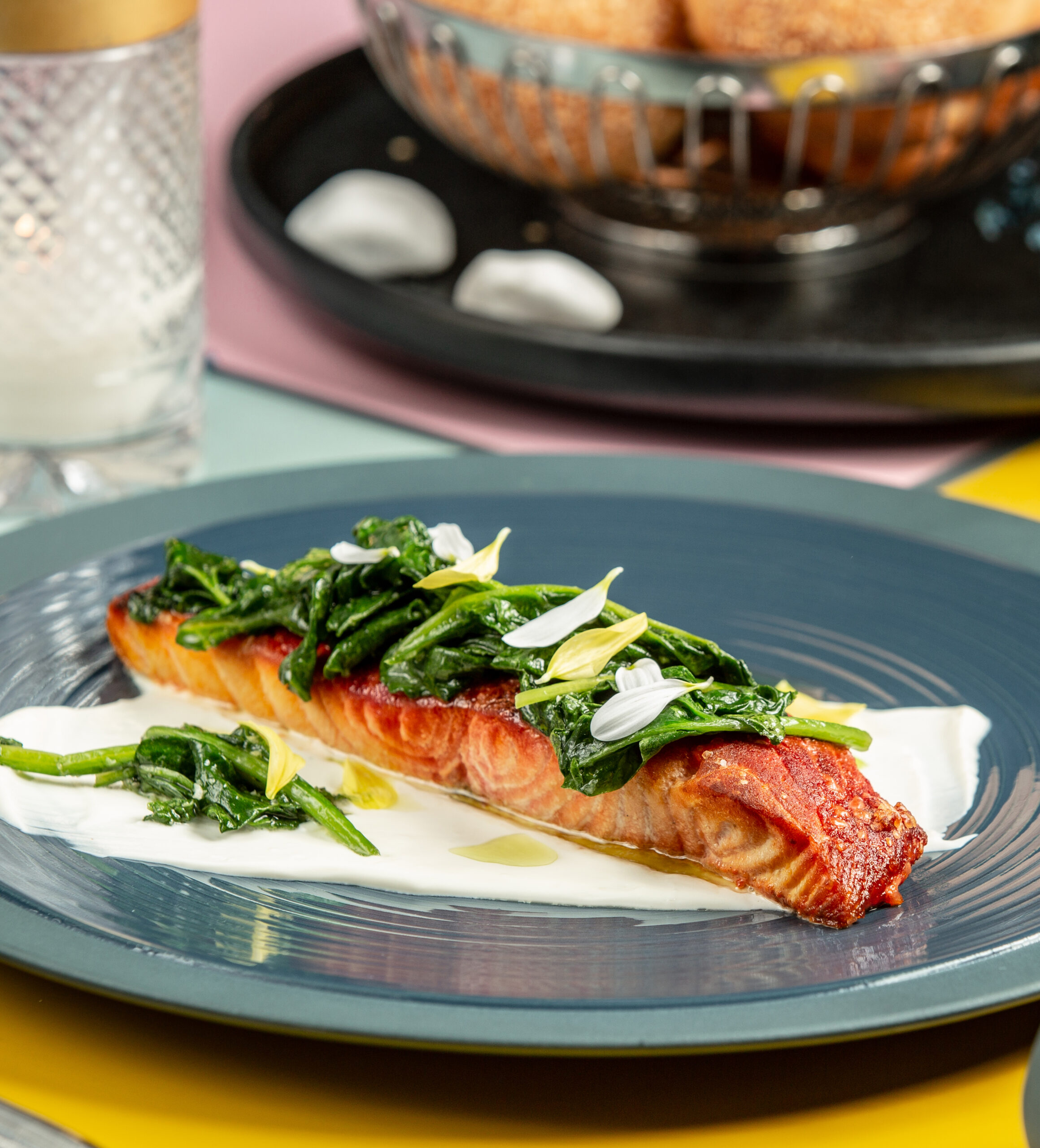Introduction
Baked salmon with garlic butter and asparagus is a classic dish that balances simplicity with sophistication. Whether you’re a seasoned chef or a beginner in the kitchen, this recipe offers a quick yet elegant option for weeknight dinners or special occasions.
Salmon, rich in omega-3 fatty acids, pairs beautifully with the earthy freshness of asparagus. The garlic butter adds a luxurious, savory touch, enhancing the natural flavors of the ingredients. This dish is not only a feast for your taste buds but also a nutritious choice for maintaining a healthy diet.
In this guide, we’ll explore how to prepare the perfect baked salmon with garlic butter and asparagus. From ingredient selection to plating suggestions, you’ll learn all the steps to create a memorable meal at home.
Ingredients and Preparation
Ingredients and Preparation
To make the perfect baked salmon with garlic butter and asparagus, having the right ingredients and preparing them carefully is essential. Let’s dive into the details of what you’ll need and how to get everything ready for a flawless dish.
Ingredient List
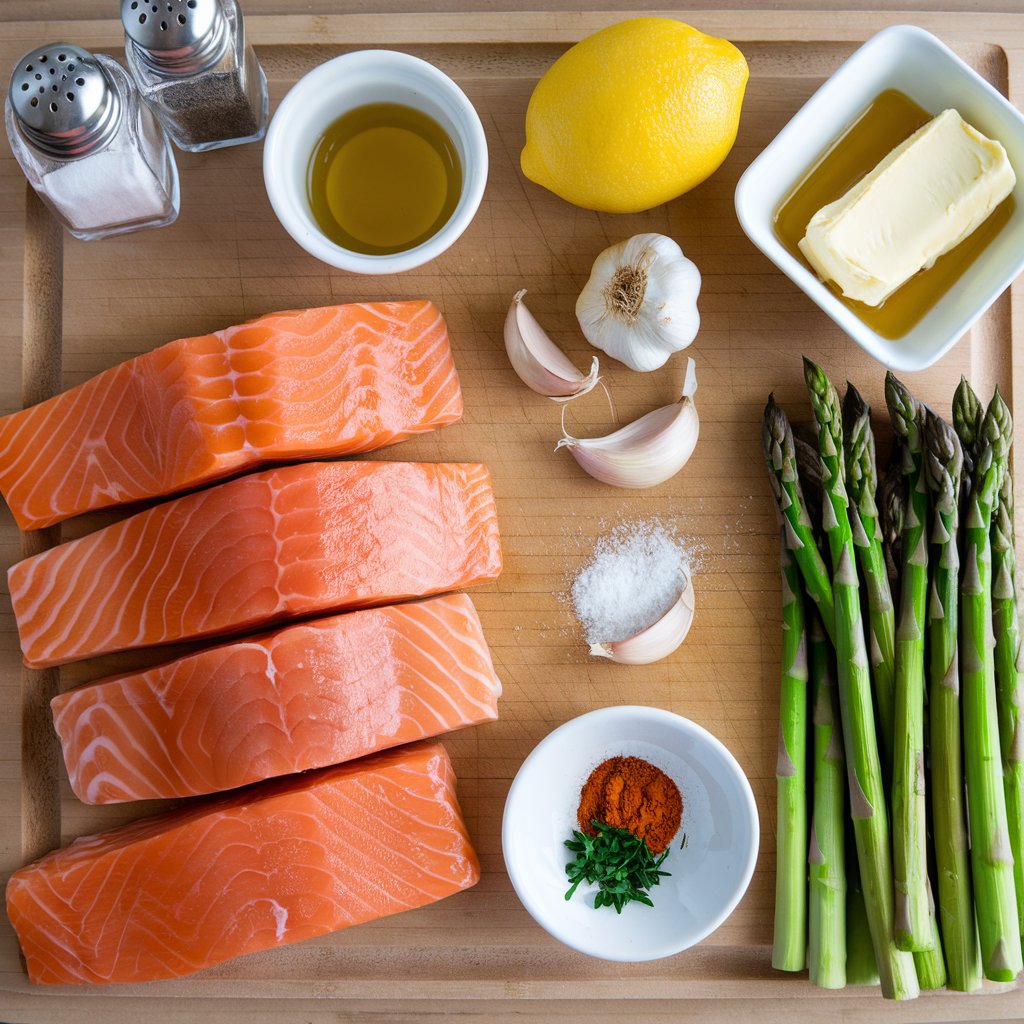
- For the Salmon and Asparagus:
- 4 salmon fillets (6–8 ounces each), skin-on or skinless as preferred
- 1 pound of fresh asparagus, trimmed
- 2 tablespoons of olive oil
- Salt and freshly ground black pepper (to taste)
- For the Garlic Butter:
- 4 tablespoons (half a stick) of unsalted butter, melted
- 4 garlic cloves, minced
- 1 tablespoon of fresh lemon juice
- 1 teaspoon of lemon zest (optional for added brightness)
- 1 teaspoon of fresh parsley, chopped (plus extra for garnish)
- 1 pinch of red pepper flakes (optional, for a hint of heat)
Choosing Quality Ingredients
- Salmon Selection:
Opt for fresh, high-quality salmon. Wild-caught salmon is preferred for its richer flavor and firmer texture, while farmed salmon is more affordable and has a milder taste. Ensure the fillets are bright in color, have no fishy odor, and are firm to the touch. - Asparagus Tips:
Look for asparagus stalks that are bright green with tightly closed tips. Avoid any with a mushy texture or yellowing ends. Thicker stalks work well for baking, as they retain their crispness. - Butter and Garlic:
Use unsalted butter to control the sodium levels in the recipe. Fresh garlic cloves are a must for the best flavor—avoid pre-minced garlic as it lacks the intensity of fresh garlic.
Preparing the Ingredients
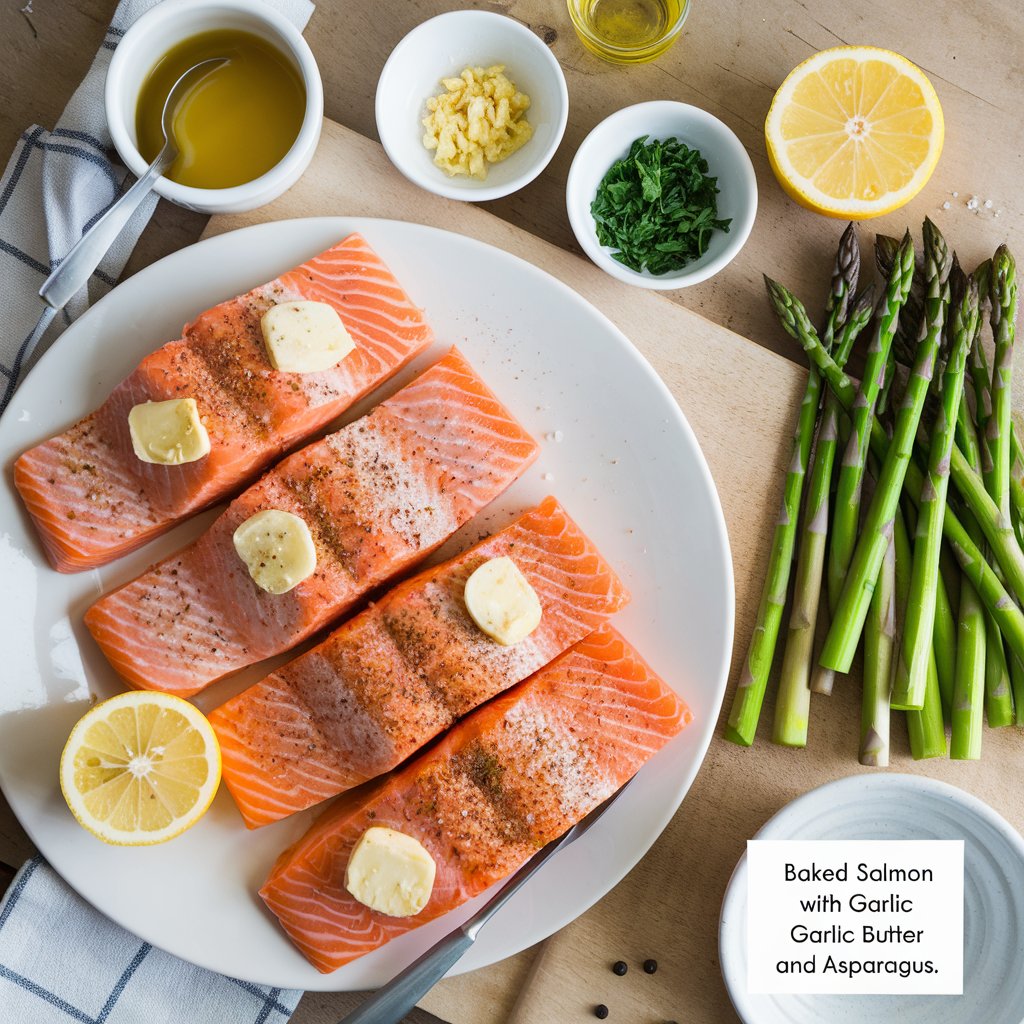
- Prepare the Salmon Fillets:
- Pat the salmon fillets dry with paper towels to remove excess moisture.
- Season both sides generously with salt and freshly ground black pepper. Set aside to let the seasoning permeate while you prepare the asparagus and garlic butter.
- Trim the Asparagus:
- Snap off the woody ends of the asparagus by bending each stalk until it naturally breaks. This ensures you’re left with tender, edible portions.
- Rinse the asparagus under cold water and pat it dry with a clean kitchen towel.
- Make the Garlic Butter:
- In a small bowl, combine the melted butter, minced garlic, lemon juice, and lemon zest (if using).
- Stir in the parsley and red pepper flakes for added flavor and set the mixture aside.
- Prepare the Baking Sheet:
- Line a large baking sheet with parchment paper or aluminum foil for easy cleanup.
- Arrange the salmon fillets in the center, leaving space between each piece. Spread the trimmed asparagus around the salmon in a single layer.
- Drizzle and Toss:
- Drizzle olive oil over the asparagus and toss them gently to coat. Season with salt and pepper.
- Spoon the prepared garlic butter generously over each salmon fillet, ensuring it also drips onto the asparagus for added flavor.
Step-by-Step Recipe Guide
Now that your ingredients are prepared, it’s time to bring everything together. Follow these simple steps to bake the salmon with garlic butter and asparagus perfectly.
Preheating and Preparing the Oven
- Preheat the Oven:
Set your oven to 400°F (200°C). A higher temperature ensures the salmon cooks quickly and remains juicy while allowing the asparagus to caramelize slightly for enhanced flavor. - Prepare the Baking Sheet:
Check your baking sheet to ensure it is evenly lined with parchment paper or foil. Lightly greasing the paper or foil with olive oil can further prevent sticking.
Arranging the Salmon and Asparagus
- Place the Salmon Fillets:
- Arrange the salmon fillets skin-side down (if using skin-on fillets) in the center of the baking sheet. Ensure there is some space between each fillet for even cooking.
- Arrange the Asparagus:
- Spread the asparagus spears around the salmon in a single layer. Overlapping can lead to uneven cooking, so make sure the asparagus has room to roast.
- Add the Garlic Butter:
- Spoon the prepared garlic butter mixture generously over each salmon fillet.
- Allow the butter to drip onto the asparagus to infuse it with the same flavors.
Baking the Salmon and Asparagus
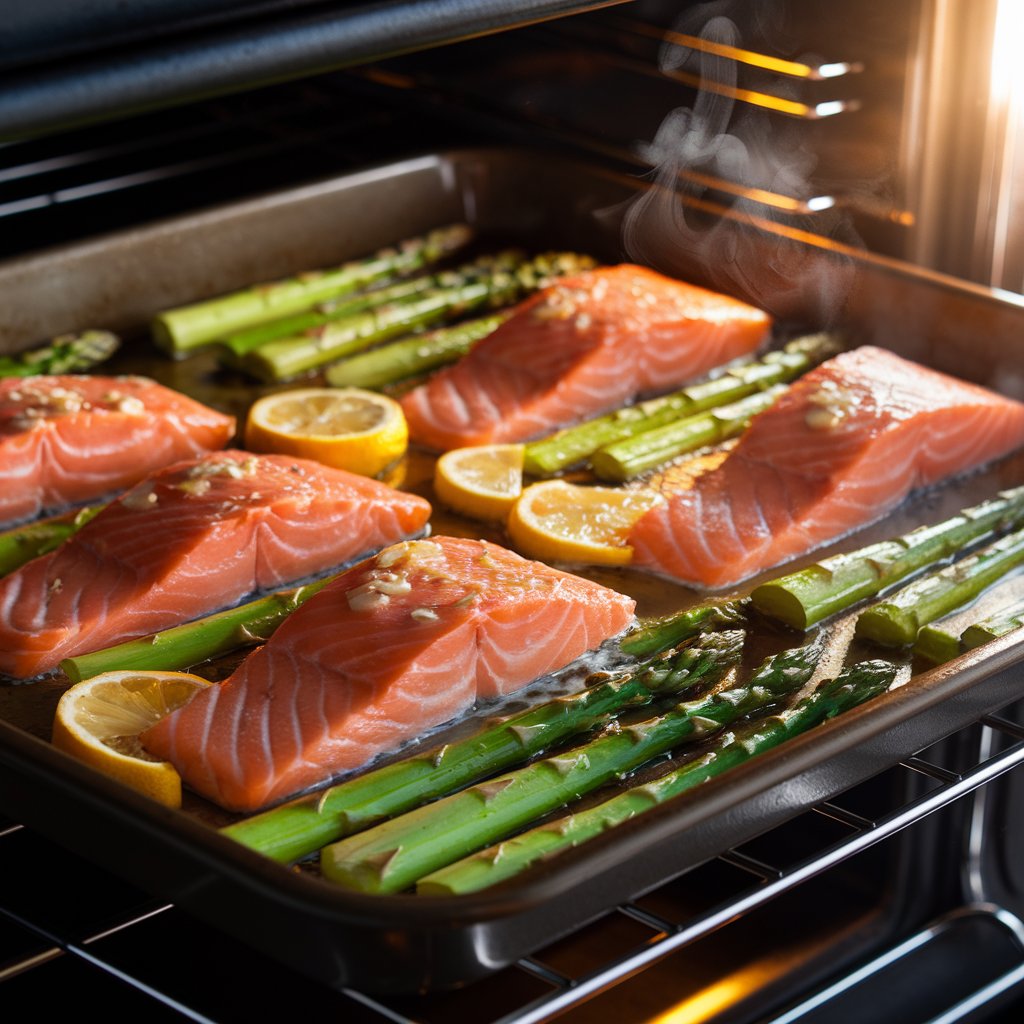
- Place in the Oven:
Carefully place the baking sheet in the preheated oven on the middle rack. - Bake for 12–15 Minutes:
- Salmon is cooked when it flakes easily with a fork and reaches an internal temperature of 145°F (63°C).
- The asparagus should be tender but still slightly crisp. Thicker asparagus spears may require an additional 2–3 minutes of cooking.
- Optional Broil for Color:
- For a golden, crispy top, switch your oven to broil mode for the last 2 minutes. Watch closely to avoid overcooking or burning the garlic butter.
Finishing Touches and Garnishing
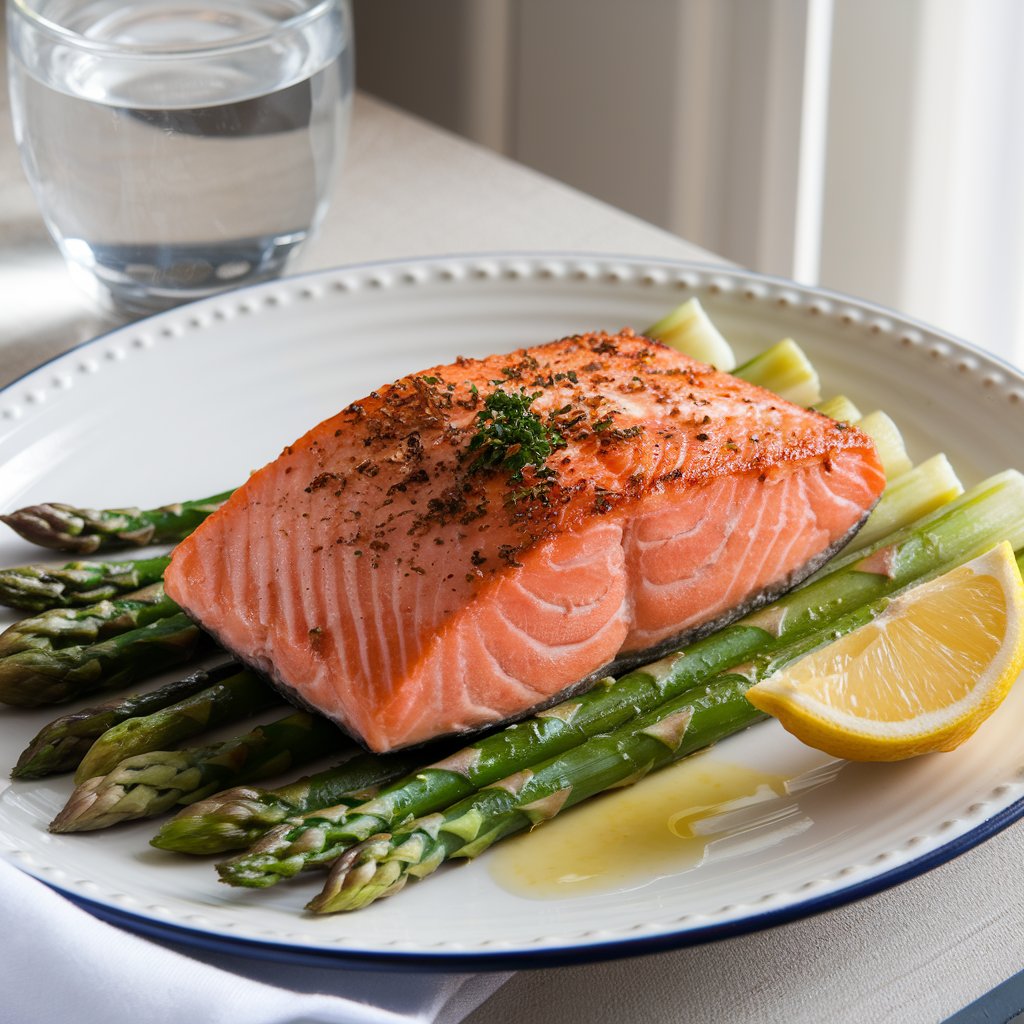
- Resting the Salmon:
Remove the baking sheet from the oven and let the salmon rest for 2–3 minutes. This allows the juices to redistribute within the fillets for maximum flavor. - Garnish and Serve:
- Sprinkle additional chopped parsley over the salmon and asparagus for a fresh touch.
- Add a slice of lemon to each plate for a bright, zesty finish.
With this simple method, you’ll achieve beautifully baked salmon that’s flaky and flavorful, complemented by perfectly roasted asparagus.
Tips for Perfect Baked Salmon
Achieving perfectly baked salmon is easier when you know a few essential tips and tricks. Whether you’re a first-time cook or an experienced chef, these tips will ensure your dish turns out flavorful and impressive every time.
Avoiding Overcooked Salmon
- Monitor Cooking Time:
- Salmon cooks quickly, usually in 12–15 minutes at 400°F (200°C). Check it at the 12-minute mark to avoid overcooking.
- Check for Doneness:
- The best way to ensure salmon is cooked through is by using a food thermometer. The internal temperature should read 145°F (63°C) in the thickest part of the fillet.
- Look for Visual Cues:
- Perfectly cooked salmon will flake easily with a fork and have a slightly opaque color in the center. Avoid baking until the fish is dry and chalky.
Enhancing Flavor
- Season Generously:
- Salt and pepper are the basics, but don’t shy away from other seasonings like smoked paprika, cumin, or dill for added complexity.
- Marinate for Extra Depth:
- Although not required, marinating the salmon for 20–30 minutes in a mixture of olive oil, garlic, and lemon juice can enhance flavor penetration.
- Infuse with Aromatics:
- Add slices of lemon, sprigs of rosemary, or thyme directly on the salmon before baking for an aromatic boost.
Achieving the Best Asparagus Texture
- Trim the Woody Ends Properly:
- Snap or cut off the tough ends of the asparagus to ensure the spears remain tender after baking.
- Toss in Olive Oil Thoroughly:
- Coating the asparagus evenly in olive oil prevents it from drying out and helps it roast evenly alongside the salmon.
- Season with Complementary Flavors:
- Aside from salt and pepper, you can sprinkle grated Parmesan or drizzle balsamic glaze over the asparagus after cooking for an extra touch of flavor.
Using the Right Equipment
- Baking Sheet Size:
- Choose a large baking sheet to prevent overcrowding, which can lead to steaming instead of roasting.
- Foil or Parchment Paper:
- Line the baking sheet with foil or parchment paper for easier cleanup and to prevent sticking.
- Using an Oven Thermometer:
- Ensure your oven is calibrated correctly with an oven thermometer to achieve consistent results.
Experimenting with Variations
- Add Vegetables:
- Include other vegetables like cherry tomatoes, zucchini, or bell peppers alongside the asparagus for a colorful and nutritious addition.
- Try a Herb Crust:
- Mix breadcrumbs, grated Parmesan, and chopped fresh herbs, then press the mixture onto the salmon before baking for a crunchy topping.
- Switch Up the Butter:
- Replace garlic butter with honey mustard or a soy-ginger glaze for a different flavor profile.
- Use Foil Packets:
- Wrap each salmon fillet and asparagus in individual foil packets for a tender, steam-infused version of the dish.
Nutritional Benefits of Baked Salmon with Garlic Butter and Asparagus
Nutritional Benefits
Baked salmon with garlic butter and asparagus is not just a culinary delight; it’s also a powerhouse of essential nutrients. This dish combines heart-healthy fats, fiber, vitamins, and antioxidants, making it a great choice for a balanced diet.
Benefits of Salmon
- Rich in Omega-3 Fatty Acids:
- Salmon is an excellent source of omega-3 fatty acids, which promote heart health, reduce inflammation, and support brain function.
- High in Protein:
- Each serving of salmon provides about 25–30 grams of protein, making it a fantastic option for muscle repair and growth.
- Packed with Vitamins and Minerals:
- Salmon is rich in B vitamins, including B12, which supports energy production and nerve health. It also contains selenium and potassium, essential for immune and cardiovascular health.
- Low in Saturated Fat:
- Compared to red meat, salmon is naturally low in unhealthy fats, making it a lean protein choice.
Health Benefits of Asparagus
- Loaded with Fiber:
- Asparagus is a great source of dietary fiber, which aids digestion and helps maintain healthy cholesterol levels.
- Rich in Antioxidants:
- It contains antioxidants like vitamin E and glutathione, which combat oxidative stress and protect cells from damage.
- Supports Bone Health:
- Asparagus is a good source of vitamin K, crucial for bone density and blood clotting.
- Low in Calories:
- With just 20 calories per half-cup serving, asparagus is a guilt-free side that doesn’t compromise on flavor.
The Role of Garlic Butter
- Garlic’s Medicinal Properties:
- Garlic contains allicin, a compound with antimicrobial and anti-inflammatory properties that may boost immunity and heart health.
- Moderate Butter Use:
- Using unsalted butter in moderation adds richness without overwhelming the dish. It provides small amounts of vitamin A and D, essential for healthy skin and bones.
- Lemon Juice Enhancement:
- The addition of lemon juice in the garlic butter not only enhances the flavor but also provides a dose of vitamin C, supporting skin health and immune function.
Balancing Macronutrients
- Healthy Fats:
- The combination of omega-3s from salmon and unsaturated fats from olive oil offers a heart-friendly fat profile.
- Low Carb, High Protein:
- This dish is naturally low in carbohydrates, making it suitable for low-carb and keto diets, while the high protein content supports satiety and energy.
- Gluten-Free and Keto-Friendly:
- With no gluten-containing ingredients, this meal is safe for individuals with gluten intolerance or celiac disease.
Ideal for Weight Management
- Calorie-Controlled:
- With salmon providing healthy fats and asparagus being low in calories, this dish is filling without being overly caloric.
- Promotes Satiety:
- The protein and fiber content help keep you feeling full, reducing the likelihood of overeating.
Supporting a Balanced Lifestyle
- Boosts Heart Health:
- The omega-3s in salmon combined with garlic’s potential cholesterol-lowering properties contribute to a heart-healthy meal.
- Improves Mental Well-Being:
- Omega-3s are linked to improved mood and cognitive function, making this dish beneficial for mental health.
- Versatile for Various Diets:
- Whether you’re focusing on paleo, keto, or Mediterranean eating patterns, this recipe can fit seamlessly into your lifestyle.
Serving Suggestions
Baked salmon with garlic butter and asparagus is a versatile dish that can be served as is or elevated with complementary sides, sauces, and beverages. Let’s explore some creative ways to present and enjoy this meal.
Pairing with Side Dishes
- Grain-Based Sides:
- Quinoa: The nutty flavor of quinoa pairs well with the savory garlic butter and enhances the dish’s protein content.
- Rice: Serve with steamed jasmine or basmati rice for a comforting and filling addition.
- Wild Rice Blend: Adds a hearty texture and earthy flavor that complements the salmon beautifully.
- Potatoes:
- Roasted Baby Potatoes: Seasoned with olive oil, rosemary, and garlic, these make a flavorful and crispy accompaniment.
- Mashed Potatoes: Creamy mashed potatoes balance the lightness of the salmon and asparagus.
- Sweet Potato Fries: Baked or air-fried sweet potato fries bring a touch of sweetness to the plate.
- Salads:
- Mixed Greens: A simple salad with arugula, spinach, and a light vinaigrette complements the richness of the salmon.
- Cucumber and Dill Salad: Adds a refreshing, crunchy contrast to the warm dish.
- Mediterranean Salad: Combine tomatoes, olives, cucumbers, and feta for a vibrant side.
Adding a Sauce or Glaze
- Lemon Dill Sauce:
- Mix Greek yogurt with fresh dill, lemon juice, and a pinch of salt for a tangy, creamy sauce.
- Honey Mustard Glaze:
- A drizzle of honey mixed with Dijon mustard creates a sweet and savory complement to the salmon.
- Garlic Aioli:
- Whip up a simple aioli with mayo, roasted garlic, and a squeeze of lemon for dipping asparagus and salmon.
Beverage Pairings
- Wine Suggestions:
- White Wine: A crisp Sauvignon Blanc or Chardonnay balances the buttery richness of the dish.
- Rosé: A dry rosé adds a touch of fruitiness without overpowering the flavors.
- Non-Alcoholic Beverages:
- Sparkling Water: Infused with lemon or cucumber, it refreshes the palate.
- Iced Green Tea: Light and earthy, it complements the dish’s natural flavors.
Presentation Tips
- Use a White Plate:
- Serving the salmon and asparagus on a white plate enhances the visual appeal, letting the vibrant green and pink hues stand out.
- Layering:
- Place a bed of asparagus spears, topped with the salmon fillet, and drizzle with extra garlic butter or sauce.
- Garnish Thoughtfully:
- Add a lemon wedge or twist and a sprinkle of parsley for a fresh and decorative touch.
Transforming Leftovers
- Salmon Salad:
- Flake leftover salmon into a salad with mixed greens, avocado, and a light vinaigrette.
- Salmon Tacos:
- Use the salmon and asparagus in soft tortillas with a dollop of sour cream and salsa for a quick taco night.
- Rice Bowls:
- Combine leftover salmon, asparagus, and rice with a drizzle of soy sauce or teriyaki for a balanced bowl.
Frequently Asked Questions (FAQs)
Here are answers to common questions about baked salmon with garlic butter and asparagus. Whether you’re troubleshooting or seeking inspiration, this section has you covered.
FAQ 1: How can I tell if my salmon is fresh?
Fresh salmon has a bright, vibrant color, firm texture, and a mild, clean smell. Avoid fillets that are dull, mushy, or have a strong fishy odor. When in doubt, ask your fishmonger for guidance.
FAQ 2: Can I use frozen salmon for this recipe?
Yes, you can use frozen salmon, but ensure it’s fully thawed before cooking. Thaw it overnight in the refrigerator or use the defrost setting on your microwave for a quicker option. Pat it dry to remove excess moisture before seasoning.
FAQ 3: What’s the best way to trim asparagus?
Hold the asparagus stalk near the bottom and bend until it snaps naturally. The snapped-off portion is the woody end that should be discarded. You can also cut the ends with a knife, but the snapping method ensures tenderness.
FAQ 4: Can I make this recipe ahead of time?
You can prepare the ingredients in advance by trimming the asparagus and seasoning the salmon. Store them separately in airtight containers in the refrigerator. Bake just before serving to preserve freshness and texture.
FAQ 5: What can I substitute for butter in this recipe?
If you’re avoiding butter, olive oil or ghee are excellent alternatives. Both provide a rich flavor and pair well with garlic and lemon. Coconut oil can also be used for a subtle tropical twist.
FAQ 6: How do I prevent my asparagus from getting soggy?
Ensure the asparagus is patted dry after washing and spread in a single layer on the baking sheet. Overcrowding can lead to steaming rather than roasting. Baking at a high temperature helps retain crispness.
Conclusion
Baked salmon with garlic butter and asparagus is a dish that combines elegance, simplicity, and exceptional flavor. Its balance of wholesome ingredients, quick preparation, and versatility makes it perfect for any occasion.
Whether you’re preparing a weeknight dinner or impressing guests at a gathering, this recipe is sure to please. By following the steps outlined, using high-quality ingredients, and incorporating tips and serving suggestions, you can confidently create a meal that’s both delicious and nutritious.
So, preheat your oven, gather your ingredients, and savor the delightful flavors of baked salmon with garlic butter and asparagus. Bon appétit!

